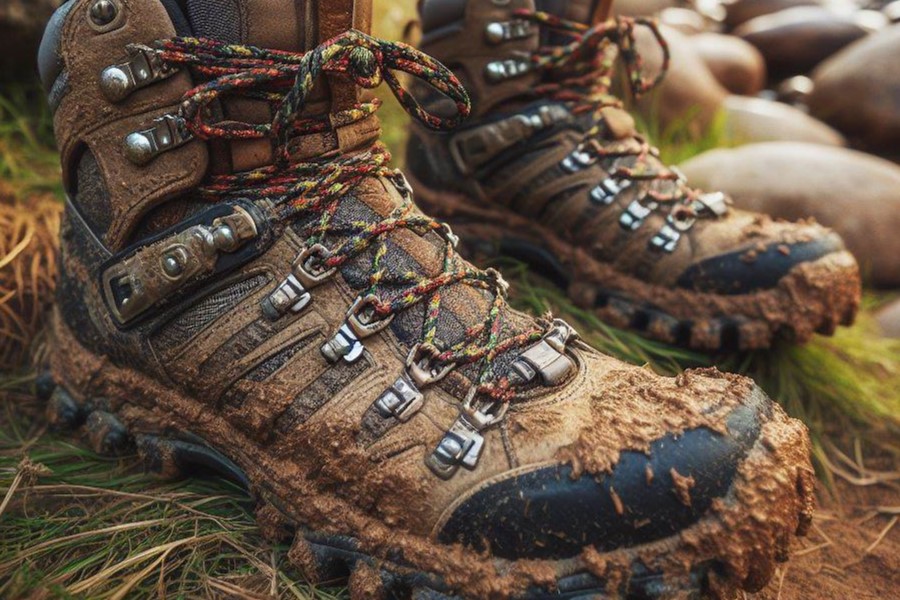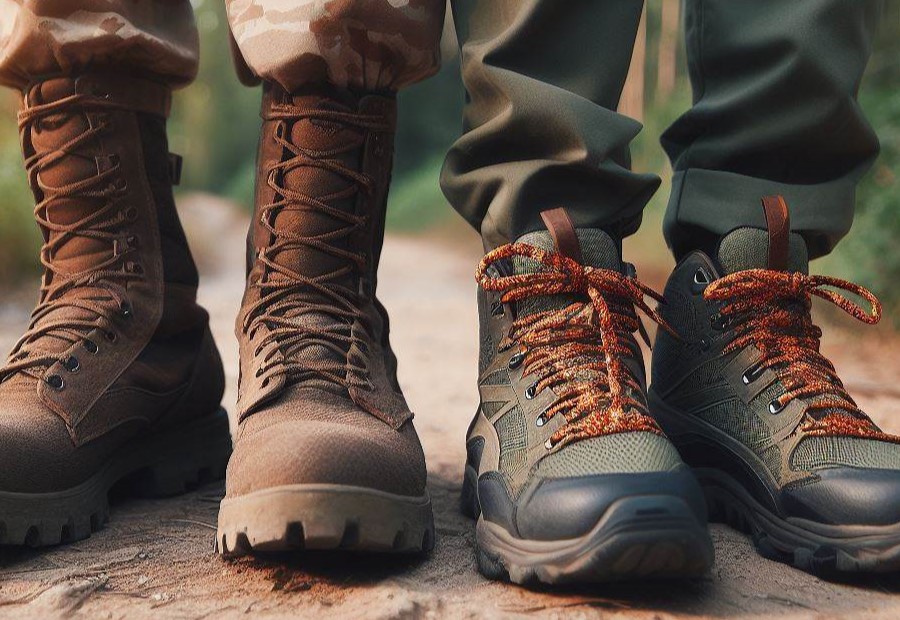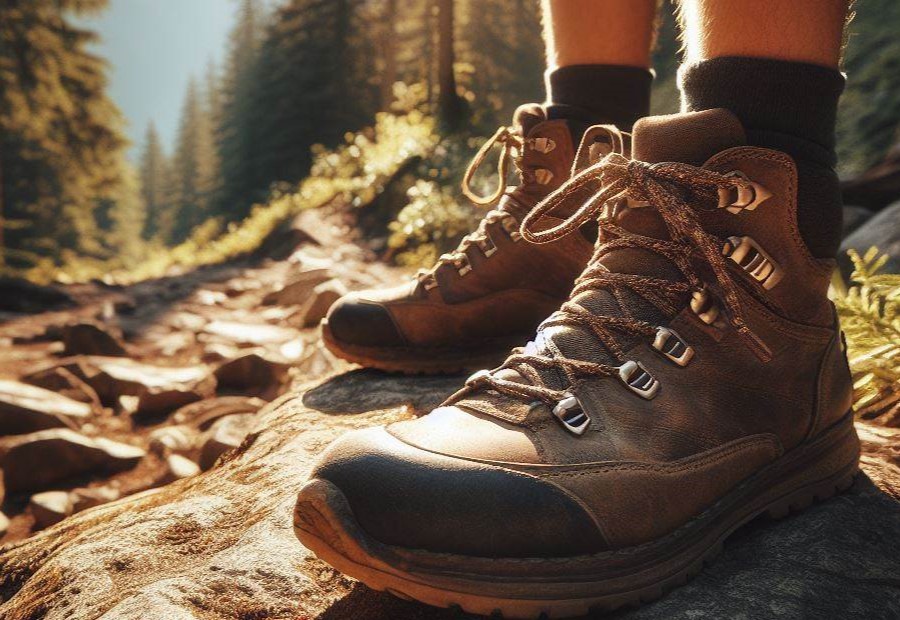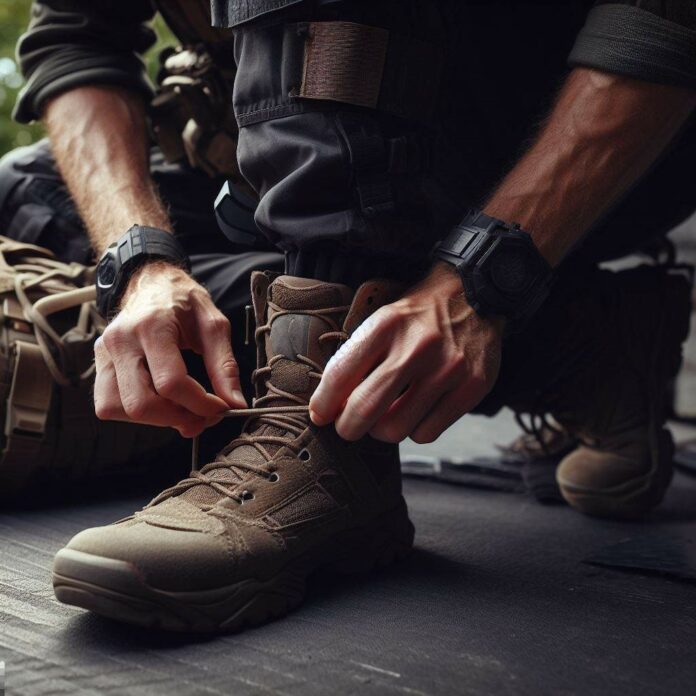Tactical and hiking boots are both popular footwear options for specific outdoor activities, but they serve different purposes and have distinct features. Understanding the differences between these two types of boots is essential to choose the right footwear for your needs.
In this article, we will explore the characteristics, materials used, and intended purposes of tactical boots and hiking boots, highlighting the key differences between them. We will also discuss factors to consider when selecting the appropriate boots based on your activity and terrain.
What are Tactical Boots?

Tactical boots, also known as combat boots, go beyond just regular footwear. They are designed to tackle demanding situations head-on and provide exceptional support and protection. In this section, we’ll dive into the world of tactical boots.
Discover their purpose, explore the impressive features they offer, and learn about the high-quality materials used in their construction. Get ready to lace up and step into the rugged realm of tactical boots.
Purpose of Tactical Boots
Tactical boots, which serve a specific purpose in various professions and activities, are designed to provide support, protection, and durability for individuals in tactical or military roles. The primary goal of these boots is to ensure the safety and performance of the wearer in challenging conditions or intense situations.
To accomplish this, tactical boots are specifically tailored with features such as reinforced toe caps, ankle support, waterproofing capabilities, and specialized traction for improved grip. The choice of materials, such as leather or synthetic fabrics, enhances durability and provides added protection.
Furthermore, tactical boots commonly come equipped with features like a moisture-wicking lining to keep feet dry and prevent the growth of odor-causing bacteria. This helps maintain comfort and hygiene even during long hours of use. Overall, tactical boots serve their purpose by meeting the unique demands of individuals in tactical roles.
Features of Tactical Boots
Tactical boots offer a range of features to meet your needs:
- Durable construction: These boots are constructed using robust materials like leather or nylon, ensuring they can withstand tough environments and extended use.
- Reinforced toe and heel: With reinforced toe caps and heel counters, tactical boots provide added protection and stability.
- Slip-resistant outsoles: The rugged and slip-resistant outsoles of tactical boots ensure excellent traction on various terrains.
- Moisture-wicking lining: Many tactical boots feature a moisture-wicking lining or breathable materials, keeping your feet dry and comfortable.
- Ankle support: Designed with padded collars and ankle support, these boots provide stability and help reduce the risk of injury.
- Speed lacing system: Some tactical boots come with a quick lacing system, making it easy and efficient to put them on and take them off.
- Removable insoles: Certain tactical boots offer removable insoles, allowing you to customize the fit or replace them when needed.
Pro-tip: When choosing tactical boots, consider the specific features that align with your needs and the activities you will be engaging in. Look for boots that offer the right combination of durability, traction, and comfort for your intended use.
Materials Used in Tactical Boots
Tactical boots often incorporate various materials such as leather, nylon, suede, rubber, EVA foam, and polyurethane to provide the required functionalities.
Full-grain leather is commonly used in tactical boots for its durability, water resistance, and excellent protection. It is resistant to abrasions and provides stability.
Nylon, known for its lightweight and breathable properties, is a popular material used in tactical boots. It offers flexibility and allows for quick drying.
Suede is employed in the upper part of tactical boots as it is soft, comfortable, and adds a stylish appearance.
For enhanced traction and grip on various surfaces, tactical boots use rubber outsoles. The rubber also provides resistance to oil and other hazardous substances.
EVA foam is often incorporated in the midsoles of tactical boots for cushioning and shock absorption. This helps reduce foot fatigue and provides comfort during long hours of wear.
Polyurethane is a durable and lightweight material utilized in tactical boots. It offers additional support, stability, and helps maintain the shape of the boot while resisting compression.
One interesting fact about tactical boots is that they are specifically designed to meet the needs of military and law enforcement personnel. These boots provide features that enhance performance and safety in challenging environments.
What are Hiking Boots?

Hiking boots are an essential gear for outdoor enthusiasts, offering reliable traction and support on challenging terrains. In this section, we’ll dive into the world of hiking boots and uncover what makes them a must-have for hikers.
From their purpose in providing stability to the various features that enhance performance, and the materials used to ensure durability, we’ll explore the essentials of what sets hiking boots apart. Get ready to hit the trails with confidence!
Purpose of Hiking Boots
Hiking boots serve the purpose of providing support, protection, and stability to the feet and ankles while engaging in outdoor activities and walking on various terrains.
- Hiking boots have a design that enables them to handle rugged and uneven surfaces, offering superior stability and reducing the risk of ankle sprains.
- These boots provide insulation and protection from the elements, ensuring dry and comfortable feet even in wet or cold conditions.
- The rugged outsole of hiking boots offers exceptional traction and grip, preventing slips and falls on slippery or muddy surfaces.
- Hiking boots are constructed using durable materials such as leather or synthetic fabrics, allowing them to withstand the rigors of hiking and deliver long-lasting performance.
- They often feature reinforced toe caps and heel counters to provide protection against rocks, roots, or other obstacles encountered on the trail.
- The design of hiking boots typically incorporates cushioning and support in the midsole to absorb shock and reduce fatigue during extended hikes.
- By featuring a higher cut, hiking boots offer ankle support, minimizing the risk of sprains or twists when navigating rough terrain.
- These boots are specifically designed for outdoor activities like hiking, backpacking, trekking, and mountaineering.
Features of Hiking Boots
Waterproof: Hiking boots often incorporate waterproof materials such as Gore-Tex to ensure your feet stay dry in wet conditions.
Ankle support: Hiking boots are designed with a higher cut than regular shoes, offering enhanced ankle stability and injury prevention.
Traction: Hiking boots typically feature lugged soles that provide exceptional grip on various terrains, including slippery or rocky surfaces.
Toe protection: Hiking boots commonly include reinforced toe caps to safeguard your toes against impacts and stubbing.
Breathability: Many hiking boots incorporate breathable materials and mesh panels to allow air circulation, preventing sweaty feet.
Cushioning: Hiking boots usually incorporate cushioning in the midsole, delivering comfort and shock absorption while walking on uneven terrain.
Materials Used in Hiking Boots
Hiking boots are often made from high-quality leather, such as full-grain or nubuck leather. These materials, including leather, provide durability, water resistance, and protection against rough terrains.
Some hiking boots are made using synthetic materials like nylon, polyester, or mesh. These synthetic materials are lightweight, breathable, and offer quicker drying times.
Many hiking boots feature waterproof membranes like Gore-Tex or eVent. These waterproof membranes are inserted between the outer material and the lining, providing excellent waterproofing while still allowing breathability.
Hiking boots commonly have rubber outsoles, which offer superior traction on various surfaces. The rubber used in the outsoles is often durable and resistant to wear and tear.
Hiking boots utilize midsoles made of EVA (ethylene-vinyl acetate) or PU (polyurethane). These midsole materials provide cushioning, shock absorption, and stability, ensuring comfort and support during long hikes.
Some hiking boots have a shank, which is a stiff insert placed between the insole and outsole. The shank adds rigidity to the boot, reducing foot fatigue and offering better support on rugged terrains.
Hiking boots typically have secure and adjustable lacing systems. These laces ensure a snug fit and allow for customization based on individual foot shape and preferences.
Key Differences between Tactical and Hiking Boots

When it comes to footwear, tactical boots and hiking boots may seem similar at first glance, but they serve distinct purposes. From their design and style to their durability and construction, we’ll discover how these aspects impact their performance.
We’ll also delve into their traction and grip, comfort and fit, as well as their intended use and activities. Lace up and get ready to learn which boots are best suited for your adventures!
Design and Style
| Design | Tactical Boots | Hiking Boots |
| Appearance | Tactical boots have a rugged and military-inspired design and style. They often have a muted color palette, such as black, brown, or camouflage patterns. | Hiking boots have a more outdoorsy and casual design and style. They usually come in earthy tones like brown and green and feature a sporty design. |
| Materials | Tactical boots are typically made of durable materials like full-grain leather or synthetic fabrics. They may also incorporate features like reinforced toe caps and ankle support. | Hiking boots are made from lightweight and breathable materials such as mesh, suede, or synthetic fabrics. They prioritize flexibility and comfort for long-distance walking. |
| Style | Tactical boots often have a lace-up design and style with additional side zippers or Velcro closures for quick and secure fit. They may also feature high-top or mid-top profiles for added ankle support. | Hiking boots typically have a lace-up design and style that allows for a customizable fit. They often come with padded collars and tongues for enhanced comfort during long hikes. |
Pro-tip: When choosing between tactical and hiking boots based on design and style, consider the environment and activities in which you will be using them. Tactical boots are suitable for military and law enforcement professionals or individuals who prefer a more rugged and utilitarian look.
On the other hand, hiking boots are designed for outdoor enthusiasts and provide the necessary comfort and performance for long hikes or walks in nature.
Durability and Construction
The durability and construction of both tactical and hiking boots are crucial factors to consider when selecting the appropriate footwear for your needs. By comparing these aspects, you can determine the key differences between these two boot types.
| Aspect | Tactical Boots | Hiking Boots |
| Durability | Tactical boots are specifically designed to endure demanding activities and harsh conditions. They are constructed using high-quality materials like full-grain leather and durable synthetic fabrics, ensuring long-lasting performance. | Hiking boots also prioritize durability, but their construction may focus on lightweight materials to enhance comfort during long hikes. Typically, they include sturdy leather or synthetic uppers combined with rugged outsoles, ensuring durability across various terrains. |
| Construction | Tactical boots are engineered with intensive use in mind. They frequently feature reinforced stitching and protective elements such as toe caps and ankle support. The construction aims to provide stability and protection, making them suitable for demanding tasks. | Hiking boots are meticulously constructed to offer optimal support and cushioning during extended periods of walking or hiking. They incorporate cushioned midsoles, supportive shanks, and ergonomic designs that maximize comfort and prevent foot fatigue. |
When contemplating your intended activities and the level of durability and construction required, consider whether you engage in high-impact activities and rugged terrains. In such cases, tactical boots with their durable construction would be a fitting choice.
On the other hand, if your primary activities involve hiking or walking across various terrains, hiking boots with emphasis on comfort and support may be more appropriate.
Traction and Grip
When it comes to choosing the right boots, traction and grip are crucial factors to consider. Good traction and grip provide stability and prevent slips and falls, especially in challenging terrains or slippery conditions.
- Outsole Design: Look for boots with a well-designed outsole that features deep lugs or treads. These patterns help to maximize traction by providing a better grip on various surfaces.
- Material: The material of the outsole plays a significant role in traction and grip. Rubber outsoles are known for their excellent traction properties, offering reliable grip on different surfaces.
- Flexibility: Boots with a flexible sole allow the outsole to contour to the ground, increasing the contact area and improving traction.
- Enhanced Traction Technologies: Some boots come with advanced traction technologies, such as Vibram or Gore-Tex, which provide superior grip and traction even in wet or icy conditions.
- Additional Features: Look for boots with features like heel brakes or multidirectional lugs, as these can further enhance traction and grip.
Choosing the Right Boots for Your Needs

When it comes to finding the perfect pair of boots, it’s important to consider your specific needs. In this section, we’ll dive into the factors that can help you choose the right boots for your activities and terrain.
Whether you’re planning a challenging hike or tactical mission, we’ll explore how to prioritize your needs and make an informed decision. So, let’s lace up and begin our journey towards finding the ideal boots for your adventures!
Evaluate Your Terrain
Evaluate your terrain to choose the right boots. Consider the type of terrain, whether it is rocky, muddy, slippery, or uneven.
Assess the level of difficulty and the challenges the terrain presents. Take into account the climate and weather conditions of the terrain.
Look for boots with appropriate traction and grip to navigate the terrain safely.
Consider the ankle support provided by the boots for stability on uneven terrain.
Evaluate the level of waterproofing or water resistance needed for wet or damp terrains.
Consider the breathability of the boots for hot or humid terrains.
Assess the durability and ruggedness of the boots to withstand the demands of the terrain.
Take into account any specific features that may be necessary for the terrain, such as insulation for cold terrains.
Consider the weight and flexibility of the boots for ease of movement on different terrains.
Evaluate the comfort and fit of the boots to ensure they can be worn for extended periods on the terrain.
Consider any specific requirements or preferences you may have based on your past experiences on similar terrains.
Prioritize Your Needs
Prioritizing your needs is essential when choosing the right boots for your activities. Consider the following factors:
- Activity: Determine the primary purpose of your boots. Are you planning to go hiking, hunting, or engaging in tactical operations? Different activities require specific features and capabilities.
- Terrain: Assess the terrain you’ll be encountering. Will you be walking on rugged mountain trails, rocky terrains, or urban settings? The type of terrain affects the required traction, durability, and ankle support.
- Protection: Evaluate the level of protection you need. Are you exposed to potential hazards like sharp objects, extreme weather conditions, or rough terrain? Look for boots that offer reinforced toe caps, waterproof materials, and ankle support to prioritize your safety.
- Comfort: Consider your comfort level. Are you planning long hikes or standing for extended periods? Look for boots with cushioned insoles, proper arch support, and breathable materials to ensure comfort throughout your activities.
- Fit: Pay attention to the fit of the boots. Proper sizing is crucial for preventing blisters, discomfort, and possible injuries. Consider trying on different brands and styles to find the perfect fit.
Prioritizing your needs will ensure that you choose boots that are specifically designed for your intended activities, provide the necessary protection and comfort, and enhance your overall performance.
Footwear has come a long way since its inception. Early humans used animal hides and furs to protect their feet from harsh terrain. As civilizations advanced, people began crafting shoes from various materials such as leather, wood, and even straw.
By prioritizing your needs and choosing boots tailored to your specific requirements, you ensure optimal performance and comfort during your chosen activities.
Frequently Asked Questions
What’s the difference between tactical and hiking boots?
Tactical boots and hiking boots are two different types of footwear designed for outdoor activities. Tactical boots are built to protect the feet under extreme stress and are often worn by civilians in rugged and uneven terrains. They are lightweight, comfortable, and offer optimal protection.
Hiking boots, on the other hand, are designed to provide extra stability, grip, and balance on uneven terrain. They have a thicker sole to reduce the risk of ankle injury and provide traction on slippery surfaces.
What are the advantages of tactical boots for hiking?
Tactical boots provide better ankle support compared to most hiking shoes. They are lightweight, comfortable, and offer optimal protection, making them suitable for off-trail hiking or extreme weather conditions.
Tactical boots also have a stylish look, which some individuals prefer over traditional hiking boots.
What are the advantages of hiking boots for hiking?
Hiking boots are rugged and provide balance, stability, and grip on both footpaths and uneven trails. They are sturdy and help prevent ankle injuries.
Hiking boots also offer traction on uneven surfaces and are usually weather-resistant, making them ideal for various outdoor activities.
What factors should I consider when choosing hiking boots or combat boots?
When deciding between hiking boots and combat boots, it’s important to consider factors such as flexibility, grip, traction, comfort, balance, stability, and the terrain you will be hiking on.
The rougher the terrain, the more traction, grip, support, stability, and durability you will need. Weather conditions, the duration of your hike, and the weight you need to carry should also be taken into account.

